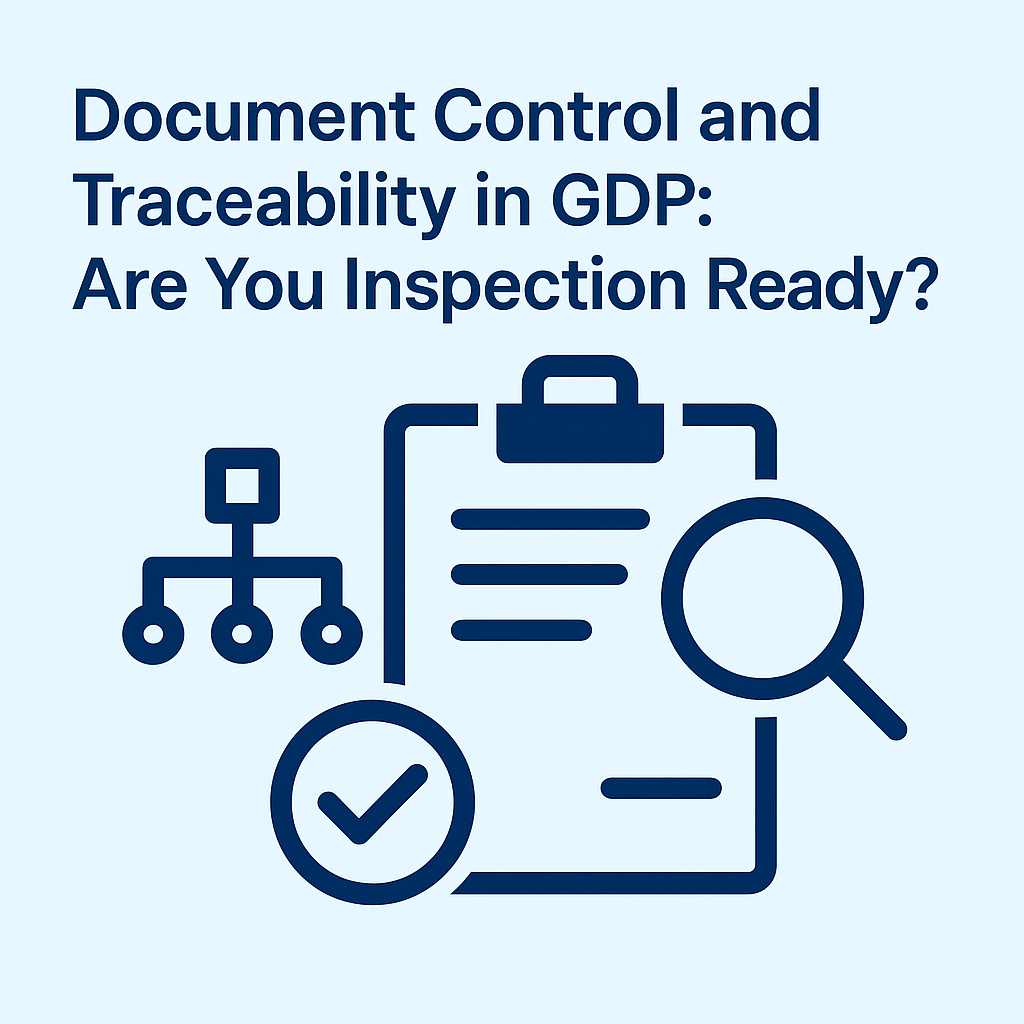In the pharmaceutical distribution chain, Good Distribution Practice (GDP) plays a pivotal role in ensuring that medicines are consistently stored, transported, and delivered under conditions that maintain their quality and integrity. While many companies focus on physical logistics, one of the most critical—but often underestimated—aspects of GDP is document control and traceability. These two pillars form the backbone of regulatory compliance and are closely scrutinised during audits and inspections.
Why Document Control and Traceability Matter in GDP
Documentation is not just paperwork—it’s the evidence of compliance. Every activity, from the receipt of goods to their delivery, must be verifiable through a well-maintained audit trail. Here’s why this is non-negotiable:
- Prevents Counterfeit or Falsified Medicines: Clear traceability makes it difficult for unauthorised or counterfeit products to enter the legitimate supply chain. Inspectors look for robust systems that flag any irregularities.
- Ensures Product Quality and Compliance: Storage conditions like temperature and humidity are crucial. Without proper records, there’s no way to prove that products were maintained within the required limits.
- Enables Rapid Recall Management: In the event of a product defect, being able to trace every unit’s journey enables swift and targeted recall, minimising patient risk and reputational damage.
- Demonstrates Accountability: GDP documentation shows that processes are followed and decisions are traceable, which is key to regulatory confidence and legal protection.
Key Components of Effective Document Control in GDP
To pass regulatory inspections, companies must ensure that their document control systems are comprehensive, secure, and aligned with GDP requirements. Here are the core elements:
1. Standard Operating Procedures (SOPs)
All document-related activities—from creation and review to approval and archiving—should be governed by up-to-date and approved SOPs. These SOPs must be:
- Easily accessible to all relevant personnel
- Reviewed regularly and revised as needed
- Aligned with both GDP guidelines and your company’s internal quality systems
2. Record Accuracy and Completeness
Records must:
- Be completed at the time of activity (not later)
- Be legible, signed, and dated
- Capture critical information such as batch numbers, storage conditions, personnel involved, and transport timelines
Incomplete or retroactively filled records are a red flag for inspectors.
3. Version Control
Using outdated SOPs or forms is a common and serious compliance issue. Ensure:
- Only current versions are in circulation
- Previous versions are archived and access restricted
- Changes are documented, justified, and approved
4. Secure Storage
Records—both physical and digital—must be protected from:
- Environmental damage (fire, water, temperature)
- Unauthorised access (using locks or password-protected systems)
- Accidental loss (using backups, cloud storage, or disaster recovery systems)
5. Retention Periods
Different regulatory authorities mandate various document retention durations. Ensure:
- Retention periods comply with regional and global regulations
- Clear policies exist for archival, retrieval, and destruction
- Documentation is easily retrievable for audits and inspections
Traceability Practices to Impress Inspectors
Document control supports traceability—but the ability to track a product’s entire lifecycle is what builds trust and ensures safety. Practices to strengthen traceability include:
Batch Tracking
Maintain end-to-end visibility of each product batch. This means being able to trace:
- Where it came from
- How it was stored and transported
- Who handled it
- Where it went
Electronic Systems
Use validated systems like WMS (Warehouse Management Systems), ERP (Enterprise Resource Planning), or specialised GDP compliance software to:
- Record data in real-time
- Reduce human error
- Provide instant access to historical records
Training
Personnel must understand:
- How to fill documentation correctly
- Why traceability is critical
- How to handle deviations or corrections
Regular refresher training should be documented and tied to SOP changes.
Internal Audits
Conduct periodic self-inspections focused specifically on documentation and traceability. These audits:
- Identify gaps before regulators do
- Help maintain a state of readiness
- Reinforce a culture of compliance
Common Inspection Findings Related to Documentation and Traceability
Many companies fall short in these areas during GDP inspections. Recurring issues include:
- Missing or Incomplete Records: Inability to produce records upon request or having gaps in batch tracking.
- Poor Version Control: Using outdated SOPs or forms leading to deviations in critical processes.
- Inadequate Returned Goods Traceability: Lack of clarity on how returned products are assessed, logged, and handled.
- Training Not Documented: Staff may be well-trained, but without proper records, it can’t be proven.
These findings often lead to observation reports, non-conformities, or even regulatory sanctions.
How Q&V Can Help You Be Inspection Ready
At Q&V, we understand that GDP compliance is not just a checkbox—it’s an ongoing commitment to safety, quality, and accountability.
We offer tailored support, including:
GDP Documentation Gap Assessments
We conduct a deep dive into your documentation systems to identify compliance gaps and offer actionable improvements.
SOP Development and Review
Whether you need new SOPs or want to refine existing ones, our experts ensure they align with GDP expectations and industry best practices.
Electronic Traceability Solutions
We help implement or optimise validated IT systems that support real-time tracking, document control, and audit readiness.
Targeted Training Programs
Regulators expect pharmaceutical distributors to prove compliance, not just claim it. Strong document control and traceability systems are your frontline defence in every GDP inspection—and more importantly, they are essential to protecting patient safety and maintaining product integrity.
Don’t wait for an audit to identify gaps in your system. Be proactive, be prepared, and stay compliant.
Ready to elevate your GDP documentation and traceability practices? Contact Q&V today for expert guidance and support.

